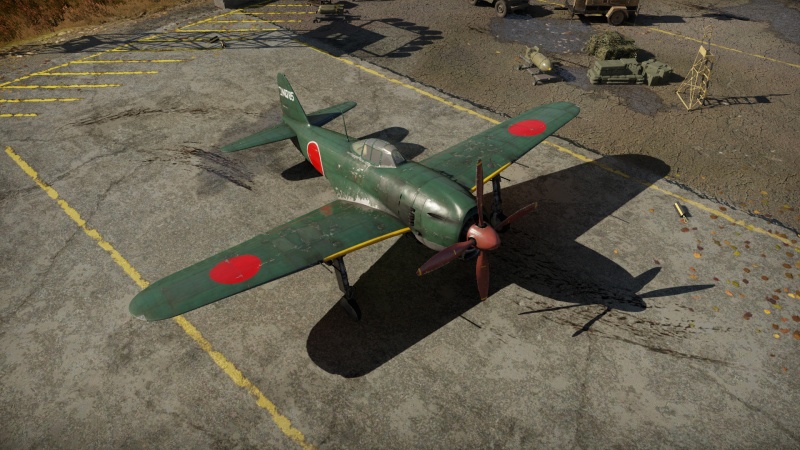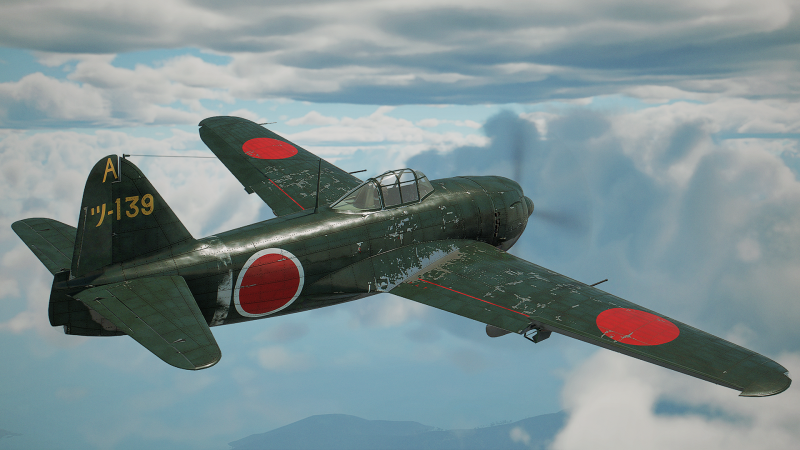N1K1-Ja
| This page is about the Japanese fighter N1K1-Ja. For other versions, see N1K (Family). |
Contents
Description
The N1K1-Ja, designated as Shiden (紫電), was the result of Kawanishi's adaptation of the canceled N1K1 floatplane project into a land-based fighter by replacing the floats with conventional landing gear. To improve the performance of the Shiden, Kawanishi swapped the original Mitsubishi Kasei 13 engine with the more powerful Nakajima Homare series, initially using the Homare 11 and later choosing the Homare 21 for mass production. The Shiden was a formidable opponent for Allied fighters over the Pacific and was the first land-based fighter designed by Kawanishi, a company specializing in floatplanes. The Shiden was quickly deployed and became the most feared Japanese fighter of the war.
It was introduced in Update 1.59 "Flaming Arrows". The N1K fighter series are famed and feared land-based fighters, and this is the first one in the line. It has great manoeuvrability at medium speeds and powerful weapons. It can out-turn most foes except some Japanese and British planes, but it lacks speed and climb performance. It is not good for diving and zooming attacks. It can fight well at 350-450 km/h and take down bombers with its big guns. It should steer clear of faster and more nimble enemies, or make them turn fight at higher speeds.
- Nicknames
- Official Designation: 紫電 (Shiden, "Violet Lightning")
- Allied reporting name: George
General info
Flight performance
| Characteristics | Max Speed (km/h at 6,200 m) |
Max altitude (metres) |
Turn time (seconds) |
Rate of climb (metres/second) |
Take-off run (metres) | |||
|---|---|---|---|---|---|---|---|---|
| AB | RB | AB | RB | AB | RB | |||
| Stock | 591 | 576 | 18.8 | 19.4 | 13.6 | 13.6 | 300 | |
| Upgraded | 637 | 614 | 17.8 | 18.0 | 23.1 | 17.8 | ||
Details
| Features | ||||
|---|---|---|---|---|
| Combat flaps | Take-off flaps | Landing flaps | Air brakes | Arrestor gear |
| ✓ | ✓ | ✓ | X | X |
| Limits | ||||||
|---|---|---|---|---|---|---|
| Wings (km/h) | Gear (km/h) | Flaps (km/h) | Max Static G | |||
| Combat | Take-off | Landing | + | - | ||
| 487 | 445 | 390 | ~14 | ~7 | ||
| Optimal velocities (km/h) | |||
|---|---|---|---|
| Ailerons | Rudder | Elevators | Radiator |
| < 430 | < 460 | < 400 | > 324 |
Survivability and armour
- 70 mm Bulletproof glass - Armoured windscreen
- 12 mm Steel plate in pilot's seat
Modifications and economy
Armaments
Offensive armament
The N1K1-Ja is armed with:
- 4 x 20 mm Type 99 Model 2 cannons, wing-mounted (100 rpg = 400 total)
- 2 x 7.7 mm Type 97 navy machine guns, nose-mounted (550 rpg = 1,100 total)
Suspended armament
The N1K1-Ja can be outfitted with the following ordnance:
- Without load
- 2 x 60 kg Navy Type 97 Number 6 bombs (120 kg total)
Usage in battles
As the first aircraft in the famed land-based N1K fighter series, the N1K1-Ja is a very interesting aircraft to fly. It will struggle to out-run or out-climb most fighters at its BR, but can make use of some nice features such as its extremely good medium-speed manoeuvrability and strong armament.
Firstly, the N1K1-Ja is slow. It's top speed is barely 600 km/h in a straight line when spaded, meaning that it will be outrun by almost every fighter at its BR, and even by some bombers too. Thus, boom & zoom will not work with this plane due to its low speed. However, the N1K1 does have a key advantage, being its great mid-speed manoeuvrability. Though it isn't as manoeuvrable as the famed A6M 'Zero', it can easily out-turn most enemies it commonly faces, save for aircraft from its own country and a few Spitfires. When in battle, utilize the N1K1-Ja's good mid-speed (350-450 km/h) manoeuvrability to win dogfights with enemies it commonly faces.
Tactics
At the start of the battle, climb up a decently achievable altitude of 3000-4000 metres. Of course, be aware that many enemies (such as the Spitfire, Bf-109 and I-225) will be able to climb faster than you. Once at altitude, look for targets to engage. Bombers are great targets as they will be shredded by the N1K1-Ja's large main armament; however, beware of their defensive guns, as the N1K1 doesn't have great armour protection and will easily be pilot-sniped or set on fire. Against other fighters, utilize your turn rate to your advantage, as the N1K1 is rather disadvantaged in most other regards. Force enemies to turn fight at slightly higher speeds, where their turn rate will be impeded.
When being pursued by other aircraft, there are several strategies to use. Firstly, against faster aircraft such as the P-47, P-51 or Fw 190, allow them to dive on you and then turn out and force them to enter a turning engagement with you. If the pilot decides to climb and disengage, there isn't much you can do as they have (typically) better climb rate and energy retention. Do not follow them up the climb, it is a death trap. Instead, disengage and fly away to engage someone else. Against more manoeuvrable targets such as the Spitfire, a variety of tactics must be used as the Spitfire can out-turn the N1K1 at lower speeds.
Specific enemies to take note of
- P-47 / P-51: This duo of American fighters, though not entirely similar, can be countered with a similar playstyle - just try to force them to turn, especially at lower speeds. The P-47 is simply horrible at turning, while the P-51 is designed for higher speeds and thus lacks low-speed manoeuvrability. Don't bother trying to follow them, especially if one has made a B & Z attempt on you and is running away - your top speed is a solid 100 km/h slower than theirs.
- Fw 190: The Fw 190s are also extremely dangerous opponents, having an excellent roll rate and great diving capabilities. Again, try to force a turnfight, as the Fw 190's turn rate is even worse than the P-47's. If they try to disengage by pulling roll-heavy manoeuvres like the scissors, do not follow them. They can out-roll you by a significant margin.
- Spitfire: The famed Spitfires are extremely hard to deal with, as the Merlin-powered ones can out-turn you while the Griffon-powered ones can out-run and out-climb you significantly. Against these aircraft, the best option is to simply seek the help of teammates, as the N1K1-Ja will likely lose against a Spitfire in a dogfight.
Manual Engine Control
| MEC elements | ||||||
|---|---|---|---|---|---|---|
| Mixer | Pitch | Radiator | Supercharger | Turbocharger | ||
| Oil | Water | Type | ||||
| Controllable | Controllable Not auto controlled |
Controllable Not auto controlled |
Controllable Not auto controlled |
Separate | Controllable 2 gears |
Not controllable |
Pros and cons
Pros:
- Reasonable manoeuvrability at medium speeds (300-500 km/h)
- Great energy retention
- Solid acceleration once upgraded
- Combat flaps are efficient while in dogfighting
- Decent rate of climb
- Powerful armament of 4 x 20 mm cannons plus 2 x 7.7 mm MGs
- Relatively good diving characteristics for a Japanese aircraft
Cons:
- Mediocre roll rate
- Severely stiffens at higher speeds
- Can be outmanoeuvred easily by the fighters at its tier if not used correctly
- Unless approached correctly, completely outclassed by the Spitfire Mk IX and F8Fs
- Ammo capacity of cannons is quite small, only 100 RPG which is far less than its later models
- Weak stock belts, which can only be unlocked at tier III
- Can catch on fire easily, and often gets destroyed in the process
History
In late 1941, as the 15-shi was still in development, some engineers were already concerned and proposed it would also be the basis of a formidable land-based fighter and a land-based version was produced as a private venture by the company. This version flew on 27 December 1942 powered by a Nakajima NK9A Homare 11 18-cylinder radial engine, replacing the less powerful Mitsubishi MK4C Kasei 13 of the N1K1.
As the navy canceled its orders on the Kyōfū, Kawanishi was opted with 3 choices:
- Repurpose the H8K, Type 2 Flying Boat as a land-based bomber
- Create a new carrier based fighter
- Repurpose the 15-shi (N1K, Kyōfū) as a land-based fighter
Kawanishi decided to further promote development of the land-based fighter version. Even though some Navy engineers showed concern that Kawanishi wouldn't be a suited designer of land-based planes due the few experience they have on land, the plane still showed great potential and was quickly evaluated by the Navy. Aside from engine problems stemming from rushed engine development and some landing gear issues, the Navy was thoroughly impressed as its speed was far faster than the A6M and its maximum range was beyond that of the Raiden and ordered its production as the N1K1-J, Shiden.
Media
- Skins
- Videos
See also
- N1K1 - (Kyofu Model 11; Base hydroplane model)
- N1K2-J - (Shiden Kai Model 21; Redesigned wings and fuselage)
- N1K2-Ja - (Shiden Kai Model 21A; More powerful engine, larger prop)
External links
| Kawanishi Aircraft Company (川西航空機) | |
|---|---|
| Fighters | J6K1 |
| N1K | N1K1-Ja · N1K2-J · N1K2-Ja |
| Bombers | H6K4 · H8K2 · H8K3 |
| Hydroplane | N1K1 · E7K2 |
| Japan fighters | |
|---|---|
| Navy | |
| Carrier-based fighter | |
| A5M | A5M4 · Hagiri's A5M4 |
| A6M | A6M2 mod. 11 · A6M2 · A6M3 · A6M3 mod. 22 · A6M3 mod. 22Ko · A6M5 · A6M5 Ko · A6M5 otsu · A6M5 Hei · A6M6c |
| A7He | A7He1* |
| A7M | A7M1 (NK9H) · A7M2 |
| Land-based Fighter | |
| J2M | J2M2 · J2M3 · J2M4 Kai · J2M5 · J2M5 (30 mm) |
| J6K | J6K1 |
| J7W | J7W1 |
| N1K-J | N1K1-Ja · N1K2-J · N1K2-Ja |
| Fighter seaplane | |
| N1K | N1K1 |
| A6M-N | A6M2-N |
| Army | |
| Ki-10 | Ki-10-I · Ki-10-I C · Ki-10-II · Ki-10-II C |
| Ki-27 | Ki-27 otsu · Ki-27 otsu Tachiarai |
| Ki-43 | Ki-43-I · Ki-43-II · Ki-43-III otsu |
| Ki-44 | Ki-44-I · Ki-44-I 34 · Ki-44-II otsu · Ki-44-II hei |
| Ki-61 | Ki-61-I ko · Ki-61-I otsu · Ki-61-I hei · Tada's Ki-61-I hei · Ki-61-I tei · Ki-61-II Otsu Kai |
| Ki-84 | Ki-84 ko · Ki-84 otsu · Ki-84 hei |
| Ki-87 | Ki-87 |
| Ki-94 | Ki-94-II |
| Ki-100 | Ki-100 · Ki-100-II |
| Other countries | ▅F4U-1A · ▅P-51C-11-NT · ▅Bf 109 E-7 · ▅Fw 190 A-5 |
| *Imported designation of the He 112 (A6M was in development - A7M would take A7 designation after the cancelation of the A7He) | |






